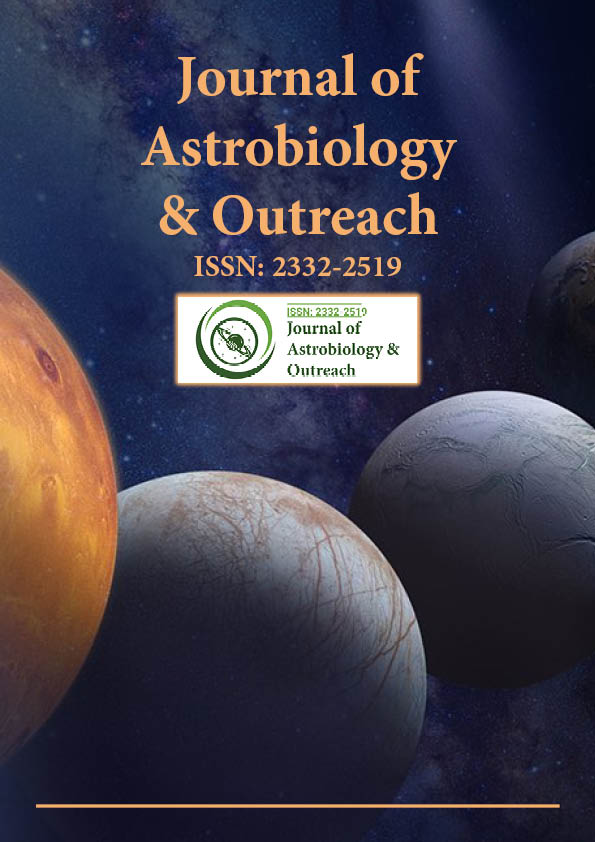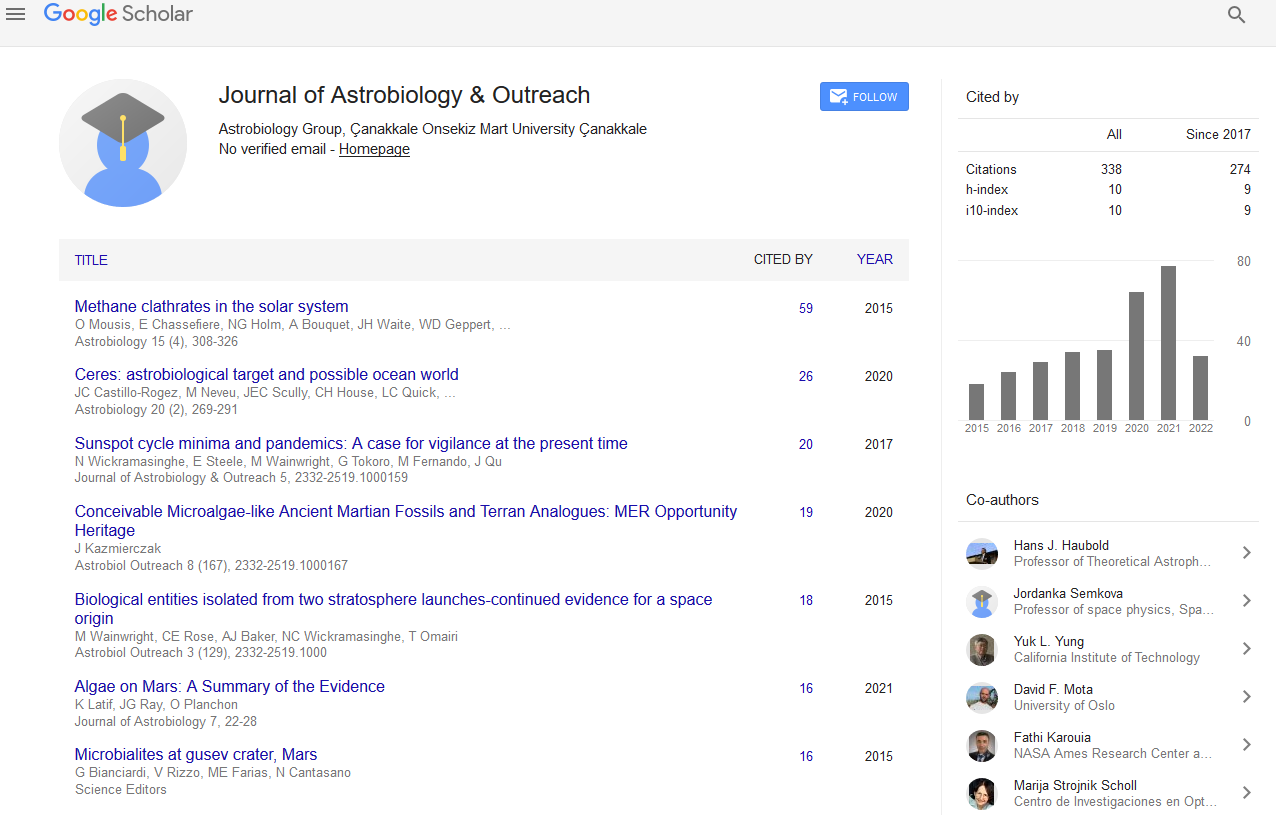Indexed In
- Open J Gate
- Academic Keys
- JournalTOCs
- RefSeek
- Hamdard University
- EBSCO A-Z
- OCLC- WorldCat
- Google Scholar
Useful Links
Share This Page
Journal Flyer

Open Access Journals
- Agri and Aquaculture
- Biochemistry
- Bioinformatics & Systems Biology
- Business & Management
- Chemistry
- Clinical Sciences
- Engineering
- Food & Nutrition
- General Science
- Genetics & Molecular Biology
- Immunology & Microbiology
- Medical Sciences
- Neuroscience & Psychology
- Nursing & Health Care
- Pharmaceutical Sciences
Commentary - (2025) Volume 13, Issue 2
Exploring the Habitability Goldilocks Zone: The Delicate Balance for Life
Chary Mark*Received: 16-Dec-2023, Manuscript No. JAO-23-24459; Editor assigned: 19-Dec-2023, Pre QC No. JAO-23-24459; Reviewed: 02-Jan-2025, QC No. JAO-23-24459; Revised: 22-Jan-2025, Manuscript No. JAO-23-24459; Published: 29-Jan-2025, DOI: 10.35248/2332-2519.25.13.374
Description
The universe is a vast expanse with countless celestial bodies, yet the search for extraterrestrial life often centers on a concept known as the habitable zone, also referred to as the Goldilocks zone. The habitable zone is the orbital region around a star where the temperature allows for liquid water to exist on the surface of a planet. This concept is not a one-size-fits-all scenario, as various factors influence the boundaries of the habitable zone. Primary among these is the luminosity of the star, determining the distance at which a planet receives just the right amount of stellar energy.
The relationship between a star's luminosity and the habitable zone is a delicate dance. A star more massive and luminous than our Sun would have a broader habitable zone, while a smaller, cooler star would have a narrower one. Consequently, scientists focus their search for potentially habitable exoplanets within these specific orbital regions, where the conditions might be conducive to life.
The influence of stellar type
Stars come in various sizes and temperatures, and their type significantly influences the habitable zone. Our Sun, a G-type main-sequence star, provides the template for the habitable zone's boundaries. However, red dwarf stars, which are smaller and cooler, have habitable zones much closer in proximity. While these stars are abundant in the universe, their proximity to their host star raises concerns about stellar flares and radiation, potentially impacting the habitability of any orbiting planets.
Conversely, larger and hotter stars, such as A-type or B-type stars, have habitable zones farther away. Yet, these stars have shorter lifespans and higher radiation levels, posing challenges for the emergence and sustenance of life as we know it. Therefore, the habitable zone is not solely dictated by distance but is intricately linked to the characteristics of the host star.
Planetary factors
While stellar characteristics play a pivotal role in defining the habitable zone, planetary factors are equally important. A planet's atmosphere, composition, and even its geological activity can influence its potential habitability. For instance, the greenhouse effect, where certain gases trap heat, can expand the habitable zone. Mars, despite being outside our Sun's habitable zone, may have had liquid water on its surface in the past due to a thicker atmosphere.
Additionally, a planet's size and mass impact its ability to retain an atmosphere. If a planet is too small, it may struggle to maintain a stable atmosphere, resulting in the loss of water and other essential elements for life. Conversely, a planet that is too large may have a thick atmosphere that traps excessive heat, rendering the surface inhospitable. Striking the right balance in size and composition is significant for a planet's habitability within the Goldilocks zone.
The Moons factor
While exoplanets are the primary focus of habitability studies, moons orbiting gas giants or even terrestrial planets can also play a significant role. These moons, like Europa and Enceladus in our own solar system, may harbor subsurface oceans beneath icy crusts. The heat generated by tidal forces from their host planets could maintain liquid water beneath the surface, offering potential havens for life. This expands the scope of habitable zones beyond the traditional understanding of planet-star relationships.
Beyond the solar system
As technology advances, astronomers are discovering an increasing number of exoplanets in the habitable zones of distant stars. The Kepler space telescope, for example, has identified thousands of exoplanets, some of which reside in the habitable zones of their host stars. Notable among these is the TRAPPIST-1 system, where seven Earth-sized planets orbit a red dwarf star, with several lying within the habitable zone. The search for habitable exoplanets continues with new missions and advancements in observational techniques.
Conclusion
While the habitable zone provides a valuable framework for narrowing down potential targets in the search for extraterrestrial life, it is not the sole criterion for habitability. The intricate interplay of stellar and planetary factors, coupled with the dynamic nature of cosmic environments, poses trials in identifying true Earth-like havens. Future missions, such as the James Webb space telescope, potential to revolutionize our understanding of exoplanetary atmospheres, compositions, and habitability. As technology evolves, so does our ability to refine the criteria for habitability and broaden the scope of our search. The habitable zone remains a significant concept, guiding astronomers in their quest to uncover the mysteries of life beyond our solar system.
Citation: Mark C (2025) Exploring the Habitability Goldilocks Zone: The Delicate Balance for Life. J Astrobiol Outreach. 13:374.
Copyright: © 2025 Mark C. This is an open-access article distributed under the terms of the Creative Commons Attribution License, which permits unrestricted use, distribution, and reproduction in any medium, provided the original author and source are credited.

